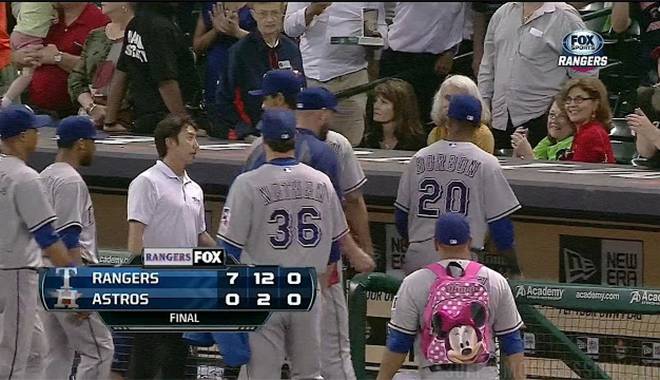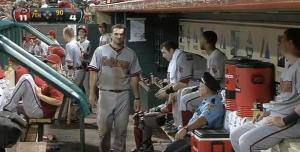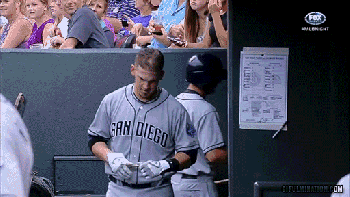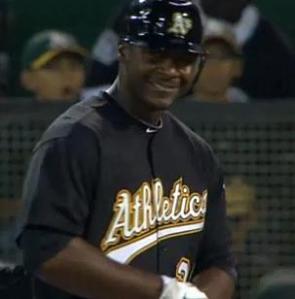 So ballplayers won’t be dressing each other up like women anymore. Depending upon one’s perspective, the latest decree against this particular subset of rookie hazing is either outrageous or long overdue. We’ve heard many opinions since the news dropped, but for the most part they’ve ignored what I think is a vital piece of the equation: Why do it in the first place?
So ballplayers won’t be dressing each other up like women anymore. Depending upon one’s perspective, the latest decree against this particular subset of rookie hazing is either outrageous or long overdue. We’ve heard many opinions since the news dropped, but for the most part they’ve ignored what I think is a vital piece of the equation: Why do it in the first place?
Rookies weren’t always made to dress like cheerleaders, of course. Like any facet of the sport’s unwritten rules, the practice had evolved over time.
Once, rookie hazing consisted mainly of failing to acknowledge a greenhorn player, sometimes to a nearly complete degree. Rookies were ignored among clubhouse conversations to the point that former Giants third baseman Jim Davenport estimated that a player in the 1950s had to accumulate at least four hundred at-bats before he was allowed so much as to speak up in the presence of veterans.
One extreme example: In 1949, Indians third baseman Ken Keltner so dominated his position that when a hotshot youngster who played the same position tried to take his rightful spot in batting practice, Keltner—abetted by various veteran teammates—chased him away. The same thing occurred when the kid grabbed a glove to work on fielding ground balls. At that point Keltner was a seven-time All-Star, and viewed the rookie as a direct threat to his job. The lockout repeated itself day after day, until the kid realized that his only way to practice was to show up early, hours before the rest of the team. Luckily for Al Rosen, a fellow rookie, Ray Boone, was willing to throw early BP for him. The following season Keltner’s fears were realized when Rosen supplanted him with a 37-homer season.
That kind of mindset has evolved, of course. With the advent of enormous signing bonuses came an increased premium on young players’ success. With the advent of enormous salaries for stars, teams are increasingly forced to lean on youngsters to fill out rosters. Once, a five-year minor league gestation period was status quo. Now, players shoot through the system in as few as one or two seasons.
So how to keep rookies in line while (mostly) avoiding the kind of overt tactics that could prove deleterious to their performance? Dressing them up was one answer. The tradition may have started with a shoe store in Atlanta that in the 1970s and ’80s sold garish footwear—wild colors and platform soles—that veterans took to foisting upon younger colleagues when passing through town. Before long, pant cuffs were cut to accentuate the shoes. Outrageous thrift-store clothes were integrated into the mix. Sixto Lezcano’s Brewers teammates dressed him all in green—suit, shirt, socks and shoes—for an entire West Coast swing. (“I looked like a fuckin’ grasshopper,” he said.) Now we see superheroes and cowboys in addition to Hooters waitresses. In 2007, Boston’s Daisuke Matsuzaka traveled to Toronto while dressed like a Teletubby.
What those decrying the new anti-drag decree seem to miss is that the act is in no way about women’s clothing. It’s about initiation, rites of passage that welcome new members into old clubs. It has no prescribed shape, only prescribed function. (At least that’s the way it should be. There’s no accounting for those who integrate sadism into the act.)
The real issues arise not when players dress up in whatever outfit is presented to them, but when they refuse. It’s an act of rebellion that, right or wrong, can fracture a player’s standing in the clubhouse. From The Baseball Codes:
After teammates on the Orioles replaced Armando Benitez’s clothes with a dress on getaway day, he refused to don the outfit and, screaming for the return of his wardrobe, pinned down a number of veterans against the far wall of the shower room with a steady barrage of baseballs picked out of a nearby bucket. In the end, the pitcher refused to capitulate, even after being told that his clothes had been packed and were already en route to the airport. “He wore a T-shirt and a pair of shorts on the frickin’ plane,” said one team member. “That didn’t sit too well with the veterans, I can tell you that.”
“The guys who make a big fuss about it, who get mad at it, they’re usually the ones who don’t last too long,” said Doug Mientkiewicz, who was forced into female clothing by his Twins teammates as a rookie in 1998. “If you can’t be mentally strong enough to wear a dress for one day when every other rookie is, too, then you’re probably not going to be mentally strong enough to handle an 0-for-35 stretch in four different cities.”
Women’s clothes are leaving big league wardrobes, but they didn’t matter anyway. Effective methods exist to welcome new members into any club, and this particular one will soldier on without missing a beat. Anybody who insists otherwise just isn’t looking hard enough.







